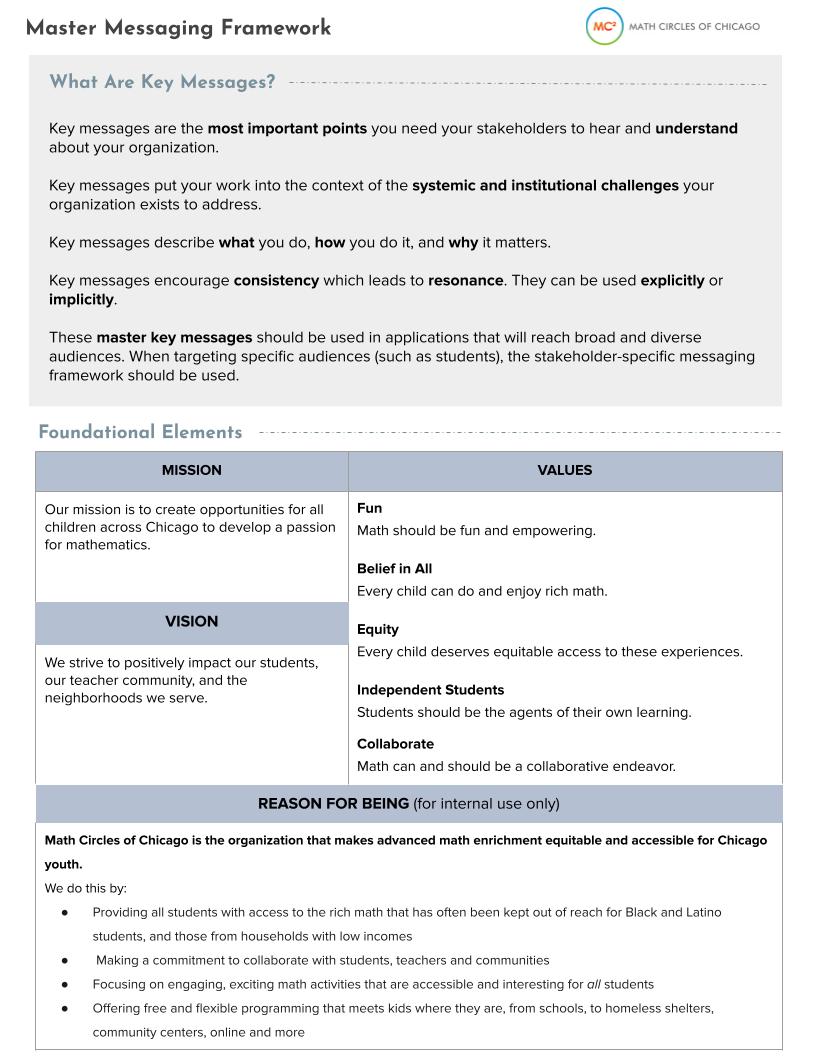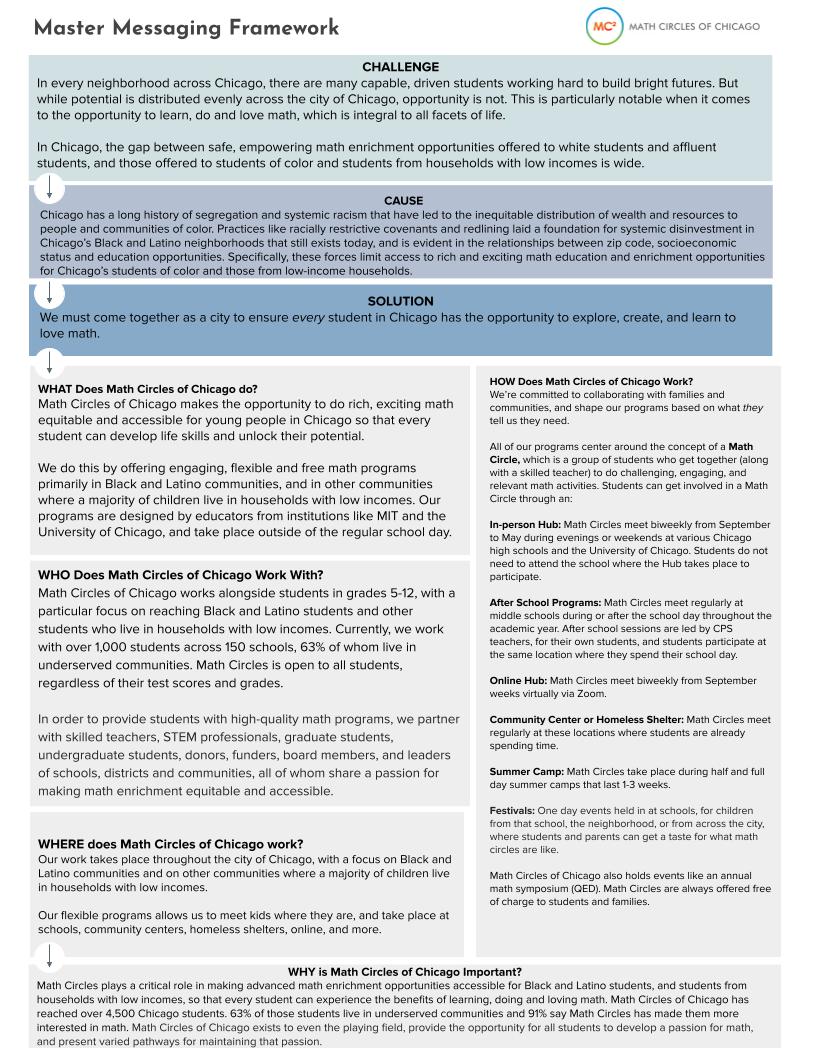Thanks for your interest the Ultimate Guide to Nonprofit Key Messages that we published a few weeks ago. This community loves concrete examples, so as a follow up to that post, we’d like to share and break down a recent messaging framework we developed in collaboration with a client of ours, Math Circles of Chicago. While your organization’s mission is likely quite different from theirs, the same principles that we used when developing their messaging can be applied to any organization, regardless of its size, structure or scope of work.
About Math Circles of Chicago and Their Messaging
Before we dive into this nonprofit messaging example, it’s important to set the stage with a bit of background on the organization we’re featuring, Math Circles of Chicago. While there is a misconception that only large nonprofits with big budgets can or should develop a messaging framework, Math Circles serves as one of many counterpoints. They’re a small, local organization that makes the opportunity to do rich, exciting math equitable and accessible for young people in Chicago through flexible and free math programs that take place outside of the regular school day. They recognized that any organization, no matter its size, can benefit from positioning itself in a consistent and compelling manner, and chose to invest in messaging in order to effectively engage more students, families, teachers, volunteers, donors and more.
Nonprofit Messaging Example: One-Pager
First, let’s take a look at Math Circles of Chicago’s messaging one-pager. Then, we’ll break it down message by message. We always create a messaging one-pager as a final deliverable in our messaging strategy engagements because they make messaging accessible and actionable for nonprofit teams. Many of our clients tell us that their team members keep messaging one-pagers posted on their desks and refer to them daily as they’re communicating on behalf of their organizations.


Section 1: Mission, Vision and Values
A nonprofit’s mission, vision and values are not strictly messaging elements. In fact they’re not typically developed during messaging engagements, but rather as part of strategic planning. Still, these elements are important to include in a messaging framework and one-pager because they’ll so often need to be referenced in external messaging. Here’s a look at Math Circles of Chicago’s mission, vision and values.
Example Nonprofit Mission Statement: Math Circles of Chicago
Our mission is to create opportunities for all children across Chicago to develop a passion for mathematics.
Example Nonprofit Vision Statement: Math Circles of Chicago
We strive to positively impact our students, our teacher community, and the neighborhoods we serve. (Note: Math Circles of Chicago may be re-evaluating this statement).
Example Nonprofit Values: Math Circles of Chicago
Fun
Math should be fun and empowering.
Belief in All
Every child can do and enjoy rich math.
Equity
Every child deserves equitable access to these experiences.
Independent Students
Students should be the agents of their own learning.
Collaborate
Math can and should be a collaborative endeavor.
Section 2: Reason for Being
A Reason for Being articulates the unique impact that only your organization is positioned to make. It is an internal aligning statement, not external messaging. However, we always include a Reason for Being in our nonprofit messaging frameworks because this statement is a powerful tool for getting communicators in the right mindset and helping them start with why. Like the rest of our messaging, the Reason for Being is grounded in deep research, including input and feedback from program participants and other stakeholders.
Example Nonprofit Reason for Being: Math Circles of Chicago
Math Circles of Chicago is the organization that makes advanced math enrichment equitable and accessible for Chicago youth.
We do this by:
- Providing all students with access to the rich math that has often been kept out of reach for Black and Latino students, and those from households with low incomes
- Making a commitment to collaborate with students, teachers and communities
- Focusing on engaging, exciting math activities that are accessible and interesting for all students
- Offering free and flexible programming that meets kids where they are, from schools, to homeless shelters, community centers, online and more
Section 3: Systems-Level Messaging
As we covered in our recent guide to nonprofit key messages, systems-level messaging puts your nonprofit’s work in the context of the broader systemic challenges and issues your organization exists to address. They’re not about your organization, but rather about the bigger picture you’re part of, and the broad challenges you’re working to overcome in partnership with other organizations and entities. Systems level messaging includes three components: challenge, cause and solution.
Example Systems-Level Messaging: Math Circles of Chicago
Challenge
In every neighborhood across Chicago, there are many capable, driven students working hard to build bright futures. But while potential is distributed evenly across the city of Chicago, opportunity is not. This is particularly notable when it comes to the opportunity to learn, do and love math, which is integral to all facets of life.
In Chicago, the gap between safe, empowering math enrichment opportunities offered to white students and affluent students, and those offered to students of color and students from households with low incomes is wide.
Cause
Chicago has a long history of segregation and systemic racism that have led to the inequitable distribution of wealth and resources to people and communities of color. Practices like racially restrictive covenants and redlining laid a foundation for systemic disinvestment in Chicago’s Black and Latino neighborhoods that still exists today, and is evident in the relationships between zip code, socioeconomic status and education opportunities. Specifically, these forces limit access to rich and exciting math education and enrichment opportunities for Chicago’s students of color and those from low-income households.
Solution
We must come together as a city to ensure every student in Chicago has the opportunity to explore, create, and learn to love math.
Section 4: Master Key Messages / Explainer Messaging
Master Key messages are the “top level” points you need your stakeholders to hear and understand about your organization. They should be able to be used with all your audiences in settings where a range of different stakeholders might see them, such as on your website. See those top level points come to life in the nonprofit messaging example below.
Example Master Key Messages: Math Circles of Chicago
WHAT Does Math Circles of Chicago do?
Math Circles of Chicago makes the opportunity to do rich, exciting math equitable and accessible for young people in Chicago so that every student can develop life skills and unlock their potential.
We do this by offering engaging, flexible and free math programs primarily in Black and Latino communities, and in other communities where a majority of children live in households with low incomes. Our programs are designed by educators from institutions like MIT and the University of Chicago, and take place outside of the regular school day.
WHO Does Math Circles of Chicago Work With?
Math Circles of Chicago works alongside students in grades 5-12, with a particular focus on reaching Black and Latino students and other students who live in households with low incomes. Currently, we work with over 1,000 students across 150 schools, 63% of whom live in underserved communities. Math Circles is open to all students, regardless of their test scores and grades.
In order to provide students with high-quality math programs, we partner with skilled teachers, STEM professionals, graduate students, undergraduate students, donors, funders, board members, and leaders of schools, districts and communities, all of whom share a passion for making math enrichment equitable and accessible.
WHERE does Math Circles of Chicago work?
Our work takes place throughout the city of Chicago, with a focus on Black and Latino communities and on other communities where a majority of children live in households with low incomes.
Our flexible programs allows us to meet kids where they are, and take place at schools, community centers, homeless shelters, online, and more.
HOW Does Math Circles of Chicago Work?
We’re committed to collaborating with families and communities, and shape our programs based on what they tell us they need.
All of our programs center around the concept of a Math Circle, which is a group of students who get together (along with a skilled teacher) to do challenging, engaging, and relevant math activities. Students can get involved in a Math Circle through an:
- In-person Hub: Math Circles meet biweekly from September to May during evenings or weekends at various Chicago high schools and the University of Chicago. Students do not need to attend the school where the Hub takes place to participate.
- After School Program: Math Circles meet regularly at middle schools during or after the school day throughout the academic year. After school sessions are led by CPS teachers, for their own students, and students participate at the same location where they spend their school day.
- Online Hub: Math Circles meet biweekly from September weeks virtually via Zoom.
- Community Center or Homeless Shelter: Math Circles meet regularly at these locations where students are already spending time.
- Summer Camp: Math Circles take place during half and full day summer camps that last 1-3 weeks.
- Festivals: One day events held in at schools, for children from that school, the neighborhood, or from across the city, where students and parents can get a taste for what math circles are like.
Math Circles of Chicago also holds events like an annual math symposium (QED). Math Circles are always offered free of charge to students and families.
WHY is Math Circles of Chicago Important?
Math Circles plays a critical role in making advanced math enrichment opportunities accessible for Black and Latino students, and students from households with low incomes, so that every student can experience the benefits of learning, doing and loving math. Math Circles of Chicago has reached over 4,500 Chicago students. 63% of those students live in underserved communities and 91% say Math Circles has made them more interested in math. Math Circles of Chicago exists to even the playing field, provide the opportunity for all students to develop a passion for math, and present varied pathways for maintaining that passion.
Are you ready to develop your nonprofit’s messaging framework?
I hope this nonprofit messaging example serves as inspiration. But before you get started working on your messaging framework, it’s so important to note that the messages above were developed through collaboration with Math Circles of Chicago and its stakeholders, including the students and families that participate in the organization’s programs. For example, we didn’t just decide to emphasize the organization’s focus on Black and Latino communities; that messaging decision was made intentionally because we heard from stakeholders via surveys and listening sessions that they cared deeply about Math Circles’ work to address disparities in math enrichment. Make sure you take the time to conduct research and authentically engage your stakeholders before you develop a messaging framework like this one.
If you have a key message framework example or work in progress, we’d love to see it in the comments!